GREATEST COMMON FACTOR WORD PROBLEMS
Problem 1 :
Find the greatest possible length that can be used to measure exactly the lengths 84 feet, 98 feet and 126 feet.
The greatest possible length that can be used to measure the given lengths is the greatest common factor of 84, 63 and 97.
Find the greatest common factor of 84, 98 and 126.

Product of common factors of 84, 98 and 126 is
GCF (84, 98, 126) = 14.
The greatest possible length that can be used to measure the given lengths is 14 feet.
Problem 2 :
A warehouse has three shelves that can hold 8, 12, or 16 skateboards. Each shelf has sections holding the same number of skateboards. What is the greatest number of skateboards that can be put in a section? Explain
Write the factors of 8, 12 and 16.
8 = 1, 2, 4 , 8
12 = 1, 2, 3, 4 , 6, 12
16 = 1, 2, 4 , 8, 16
The greatest common factor of 8, 12 and 16 is 4.
So, the greatest number of skateboards can be put in a section is 4.
Problem 3 :
Lily has 15 oranges, 9 peaches, and 18 pears. She wants to put all of the fruit into decorative baskets. Each basket must have the same number of pieces of fruit in it. Without mixing fruits, what is the greatest number of pieces of fruit Lily can put in each basket? Explain.
Write the factors of 15, 9 and 18.
15 = 1, 2, 3 , 5, 15
9 = 1, 3 , 9
18 = 1, 2, 3 , 6, 9, 18
The greatest common factor of 15, 9 and 18 is 3.
So, the greatest number of pieces of fruit Lily can put in each basket is 3.
Problem 4 :
A store has 120 lbs and 250 lbs of two kinds of meat. The store wants to sell the meat by filling the two kinds in boxes of equal volumes and no meat left over. Find the greatest volume of such a box.
The given two quantities 120 and 250 can be divided by 2, 5, 10,... exactly. That is, both kinds of meat can be sold in boxes of equal volume of 2, 5, 10,...
But, the volume of meat filled in boxes must be greatest.
So, we have to find the largest number which exactly divides 120 and 250. That is the highest common factor (HCF) of 120 and 250.
HCF (120, 250) = 10
The 1 st kind 120 lbs is sold in 12 boxes of volume 10 lbs in each box.
The 2 nd kind 250 lbs is sold in 25 boxes of volume 10 lbs in each box.
Hence, the greatest volume of the box is 10 lbs.
Problem 5 :
Two numbers are in the ratio 2 : 3. If the second number is 27, find their greatest common factor.
Because the two numbers are in the ratio 2 : 3, the numbers can be assumed as 2x and 3x.
Find the greatest common multiple of 2x and 3x.

The common factor of 2x and 3x is x.
Greatest common factor (2x, 3x) = x
But, it is given that the second number is 27.
Divide each side by 3.
So, the greatest factor of the two numbers is 9.
Problem 6 :
Two numbers are in the ratio 3 : 5 and their greatest common factor is 18 . Find the numbers.
Because the two numbers are in the ratio 3 : 5, the numbers can be assumed as 3x and 5x.
Greatest common factor (3x, 5x) = x
But, it is given that the greatest common factor of the two numbers is 18.
Substitute x = 18 in 3x and 5x.
3x = 3(18) = 54
5x = 5(18) = 90
So, the two numbers are 54 and 90.
Kindly mail your feedback to [email protected]
We always appreciate your feedback.
© All rights reserved. onlinemath4all.com
- Sat Math Practice
- SAT Math Worksheets
- PEMDAS Rule
- BODMAS rule
- GEMDAS Order of Operations
- Math Calculators
- Transformations of Functions
- Order of rotational symmetry
- Lines of symmetry
- Compound Angles
- Quantitative Aptitude Tricks
- Trigonometric ratio table
- Word Problems
- Times Table Shortcuts
- 10th CBSE solution
- PSAT Math Preparation
- Privacy Policy
- Laws of Exponents

Recent Articles
Trigonometry Cofunction Identities
Apr 30, 24 09:01 PM
Worksheet on Unit Rates
Apr 30, 24 08:50 PM

Ratio Worksheet
Apr 29, 24 07:59 PM

Reading & Math for K-5
- Kindergarten
- Learning numbers
- Comparing numbers
- Place Value
- Roman numerals
- Subtraction
- Multiplication
- Order of operations
- Drills & practice
- Measurement
- Factoring & prime factors
- Proportions
- Shape & geometry
- Data & graphing
- Word problems
- Children's stories
- Leveled Stories
- Context clues
- Cause & effect
- Compare & contrast
- Fact vs. fiction
- Fact vs. opinion
- Main idea & details
- Story elements
- Conclusions & inferences
- Sounds & phonics
- Words & vocabulary
- Reading comprehension
- Early writing
- Numbers & counting
- Simple math
- Social skills
- Other activities
- Dolch sight words
- Fry sight words
- Multiple meaning words
- Prefixes & suffixes
- Vocabulary cards
- Other parts of speech
- Punctuation
- Capitalization
- Narrative writing
- Opinion writing
- Informative writing
- Cursive alphabet
- Cursive letters
- Cursive letter joins
- Cursive words
- Cursive sentences
- Cursive passages
- Grammar & Writing
Breadcrumbs
- Word Problems
- GCF & LCM
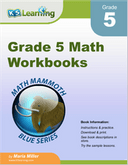
Download & Print From only $2.60
GCF and LCM word problems
Factors and multiples.
These word problems need the use of greatest common factors (GCFs) or least common multiples (LCMs) to solve. Mixing GCF and LCM word problems encourages students to read and think about the questions, rather than simply recognizing a pattern to the solutions.

These worksheets are available to members only.
Join K5 to save time, skip ads and access more content. Learn More
More word problem worksheets
Explore all of our math word problem worksheets , from kindergarten through grade 5.
What is K5?
K5 Learning offers free worksheets , flashcards and inexpensive workbooks for kids in kindergarten to grade 5. Become a member to access additional content and skip ads.
Our members helped us give away millions of worksheets last year.
We provide free educational materials to parents and teachers in over 100 countries. If you can, please consider purchasing a membership ($24/year) to support our efforts.
Members skip ads and access exclusive features.
Learn about member benefits
This content is available to members only.
- Forgot Password?
6.1 Greatest Common Factor and Factor by Grouping
Learning objectives.
By the end of this section, you will be able to:
- Find the greatest common factor of two or more expressions
- Factor the greatest common factor from a polynomial
- Factor by grouping
Be Prepared 6.1
Before you get started, take this readiness quiz.
Factor 56 into primes. If you missed this problem, review Example 1.2 .
Be Prepared 6.2
Find the least common multiple (LCM) of 18 and 24. If you missed this problem, review Example 1.3 .
Be Prepared 6.3
Multiply: −3 a ( 7 a + 8 b ) . −3 a ( 7 a + 8 b ) . If you missed this problem, review Example 5.26 .
Find the Greatest Common Factor of Two or More Expressions
Earlier we multiplied factors together to get a product . Now, we will reverse this process; we will start with a product and then break it down into its factors. Splitting a product into factors is called factoring .
We have learned how to factor numbers to find the least common multiple (LCM) of two or more numbers. Now we will factor expressions and find the greatest common factor of two or more expressions. The method we use is similar to what we used to find the LCM.
Greatest Common Factor
The greatest common factor (GCF) of two or more expressions is the largest expression that is a factor of all the expressions.
We summarize the steps we use to find the greatest common factor.
Find the greatest common factor (GCF) of two expressions.
- Step 1. Factor each coefficient into primes. Write all variables with exponents in expanded form.
- Step 2. List all factors—matching common factors in a column. In each column, circle the common factors.
- Step 3. Bring down the common factors that all expressions share.
- Step 4. Multiply the factors.
The next example will show us the steps to find the greatest common factor of three expressions.
Example 6.1
Find the greatest common factor of 21 x 3 , 9 x 2 , 15 x . 21 x 3 , 9 x 2 , 15 x .
Find the greatest common factor: 25 m 4 , 35 m 3 , 20 m 2 . 25 m 4 , 35 m 3 , 20 m 2 .
Find the greatest common factor: 14 x 3 , 70 x 2 , 105 x . 14 x 3 , 70 x 2 , 105 x .
Factor the Greatest Common Factor from a Polynomial
It is sometimes useful to represent a number as a product of factors, for example, 12 as 2 · 6 2 · 6 or 3 · 4 . 3 · 4 . In algebra, it can also be useful to represent a polynomial in factored form. We will start with a product, such as 3 x 2 + 15 x , 3 x 2 + 15 x , and end with its factors, 3 x ( x + 5 ) . 3 x ( x + 5 ) . To do this we apply the Distributive Property “in reverse.”
We state the Distributive Property here just as you saw it in earlier chapters and “in reverse.”
Distributive Property
If a , b , and c are real numbers, then
The form on the left is used to multiply. The form on the right is used to factor.
So how do you use the Distributive Property to factor a polynomial ? You just find the GCF of all the terms and write the polynomial as a product!
Example 6.2
How to use the distributive property to factor a polynomial.
Factor: 8 m 3 − 12 m 2 n + 20 m n 2 . 8 m 3 − 12 m 2 n + 20 m n 2 .
Factor: 9 x y 2 + 6 x 2 y 2 + 21 y 3 . 9 x y 2 + 6 x 2 y 2 + 21 y 3 .
Factor: 3 p 3 − 6 p 2 q + 9 p q 3 . 3 p 3 − 6 p 2 q + 9 p q 3 .
Factor the greatest common factor from a polynomial.
- Step 1. Find the GCF of all the terms of the polynomial.
- Step 2. Rewrite each term as a product using the GCF.
- Step 3. Use the “reverse” Distributive Property to factor the expression.
- Step 4. Check by multiplying the factors.
Factor as a Noun and a Verb
We use “factor” as both a noun and a verb:
Example 6.3
Factor: 5 x 3 − 25 x 2 . 5 x 3 − 25 x 2 .
Factor: 2 x 3 + 12 x 2 . 2 x 3 + 12 x 2 .
Factor: 6 y 3 − 15 y 2 . 6 y 3 − 15 y 2 .
Example 6.4
Factor: 8 x 3 y − 10 x 2 y 2 + 12 x y 3 . 8 x 3 y − 10 x 2 y 2 + 12 x y 3 .
Factor: 15 x 3 y − 3 x 2 y 2 + 6 x y 3 . 15 x 3 y − 3 x 2 y 2 + 6 x y 3 .
Factor: 8 a 3 b + 2 a 2 b 2 − 6 a b 3 . 8 a 3 b + 2 a 2 b 2 − 6 a b 3 .
When the leading coefficient is negative, we factor the negative out as part of the GCF.
Example 6.5
Factor: −4 a 3 + 36 a 2 − 8 a . −4 a 3 + 36 a 2 − 8 a .
The leading coefficient is negative, so the GCF will be negative.
Factor: −4 b 3 + 16 b 2 − 8 b . −4 b 3 + 16 b 2 − 8 b .
Try It 6.10
Factor: −7 a 3 + 21 a 2 − 14 a . −7 a 3 + 21 a 2 − 14 a .
So far our greatest common factors have been monomials. In the next example, the greatest common factor is a binomial.
Example 6.6
Factor: 3 y ( y + 7 ) − 4 ( y + 7 ) . 3 y ( y + 7 ) − 4 ( y + 7 ) .
The GCF is the binomial y + 7 . y + 7 .
Try It 6.11
Factor: 4 m ( m + 3 ) − 7 ( m + 3 ) . 4 m ( m + 3 ) − 7 ( m + 3 ) .
Try It 6.12
Factor: 8 n ( n − 4 ) + 5 ( n − 4 ) . 8 n ( n − 4 ) + 5 ( n − 4 ) .
Factor by Grouping
Sometimes there is no common factor of all the terms of a polynomial. When there are four terms we separate the polynomial into two parts with two terms in each part. Then look for the GCF in each part. If the polynomial can be factored, you will find a common factor emerges from both parts. Not all polynomials can be factored. Just like some numbers are prime , some polynomials are prime.
Example 6.7
How to factor a polynomial by grouping.
Factor by grouping: x y + 3 y + 2 x + 6 . x y + 3 y + 2 x + 6 .
Try It 6.13
Factor by grouping: x y + 8 y + 3 x + 24 . x y + 8 y + 3 x + 24 .
Try It 6.14
Factor by grouping: a b + 7 b + 8 a + 56 . a b + 7 b + 8 a + 56 .
Factor by grouping.
- Step 1. Group terms with common factors.
- Step 2. Factor out the common factor in each group.
- Step 3. Factor the common factor from the expression.
Example 6.8
Factor by grouping: ⓐ x 2 + 3 x − 2 x − 6 x 2 + 3 x − 2 x − 6 ⓑ 6 x 2 − 3 x − 4 x + 2 . 6 x 2 − 3 x − 4 x + 2 .
Try It 6.15
Factor by grouping: ⓐ x 2 + 2 x − 5 x − 10 x 2 + 2 x − 5 x − 10 ⓑ 20 x 2 − 16 x − 15 x + 12 . 20 x 2 − 16 x − 15 x + 12 .
Try It 6.16
Factor by grouping: ⓐ y 2 + 4 y − 7 y − 28 y 2 + 4 y − 7 y − 28 ⓑ 42 m 2 − 18 m − 35 m + 15 . 42 m 2 − 18 m − 35 m + 15 .
Section 6.1 Exercises
Practice makes perfect.
In the following exercises, find the greatest common factor.
10 p 3 q , 12 p q 2 10 p 3 q , 12 p q 2
8 a 2 b 3 , 10 a b 2 8 a 2 b 3 , 10 a b 2
12 m 2 n 3 , 30 m 5 n 3 12 m 2 n 3 , 30 m 5 n 3
28 x 2 y 4 , 42 x 4 y 4 28 x 2 y 4 , 42 x 4 y 4
10 a 3 , 12 a 2 , 14 a 10 a 3 , 12 a 2 , 14 a
20 y 3 , 28 y 2 , 40 y 20 y 3 , 28 y 2 , 40 y
35 x 3 y 2 , 10 x 4 y , 5 x 5 y 3 35 x 3 y 2 , 10 x 4 y , 5 x 5 y 3
27 p 2 q 3 , 45 p 3 q 4 , 9 p 4 q 3 27 p 2 q 3 , 45 p 3 q 4 , 9 p 4 q 3
In the following exercises, factor the greatest common factor from each polynomial.
6 m + 9 6 m + 9
14 p + 35 14 p + 35
9 n − 63 9 n − 63
45 b − 18 45 b − 18
3 x 2 + 6 x − 9 3 x 2 + 6 x − 9
4 y 2 + 8 y − 4 4 y 2 + 8 y − 4
8 p 2 + 4 p + 2 8 p 2 + 4 p + 2
10 q 2 + 14 q + 20 10 q 2 + 14 q + 20
8 y 3 + 16 y 2 8 y 3 + 16 y 2
12 x 3 − 10 x 12 x 3 − 10 x
5 x 3 − 15 x 2 + 20 x 5 x 3 − 15 x 2 + 20 x
8 m 2 − 40 m + 16 8 m 2 − 40 m + 16
24 x 3 − 12 x 2 + 15 x 24 x 3 − 12 x 2 + 15 x
24 y 3 − 18 y 2 − 30 y 24 y 3 − 18 y 2 − 30 y
12 x y 2 + 18 x 2 y 2 − 30 y 3 12 x y 2 + 18 x 2 y 2 − 30 y 3
21 p q 2 + 35 p 2 q 2 − 28 q 3 21 p q 2 + 35 p 2 q 2 − 28 q 3
20 x 3 y − 4 x 2 y 2 + 12 x y 3 20 x 3 y − 4 x 2 y 2 + 12 x y 3
24 a 3 b + 6 a 2 b 2 − 18 a b 3 24 a 3 b + 6 a 2 b 2 − 18 a b 3
−2 x − 4 −2 x − 4
−3 b + 12 −3 b + 12
−2 x 3 + 18 x 2 − 8 x −2 x 3 + 18 x 2 − 8 x
−5 y 3 + 35 y 2 − 15 y −5 y 3 + 35 y 2 − 15 y
−4 p 3 q − 12 p 2 q 2 + 16 p q 2 −4 p 3 q − 12 p 2 q 2 + 16 p q 2
−6 a 3 b − 12 a 2 b 2 + 18 a b 2 −6 a 3 b − 12 a 2 b 2 + 18 a b 2
5 x ( x + 1 ) + 3 ( x + 1 ) 5 x ( x + 1 ) + 3 ( x + 1 )
2 x ( x − 1 ) + 9 ( x − 1 ) 2 x ( x − 1 ) + 9 ( x − 1 )
3 b ( b − 2 ) − 13 ( b − 2 ) 3 b ( b − 2 ) − 13 ( b − 2 )
6 m ( m − 5 ) − 7 ( m − 5 ) 6 m ( m − 5 ) − 7 ( m − 5 )
In the following exercises, factor by grouping.
a b + 5 a + 3 b + 15 a b + 5 a + 3 b + 15
c d + 6 c + 4 d + 24 c d + 6 c + 4 d + 24
8 y 2 + y + 40 y + 5 8 y 2 + y + 40 y + 5
6 y 2 + 7 y + 24 y + 28 6 y 2 + 7 y + 24 y + 28
u v − 9 u + 2 v − 18 u v − 9 u + 2 v − 18
p q − 10 p + 8 q − 80 p q − 10 p + 8 q − 80
u 2 − u + 6 u − 6 u 2 − u + 6 u − 6
x 2 − x + 4 x − 4 x 2 − x + 4 x − 4
9 p 2 + 12 p − 15 p − 20 9 p 2 + 12 p − 15 p − 20
16 q 2 + 20 q − 28 q − 35 16 q 2 + 20 q − 28 q − 35
m n − 6 m − 4 n + 24 m n − 6 m − 4 n + 24
r 2 − 3 r − r + 3 r 2 − 3 r − r + 3
2 x 2 − 14 x − 5 x + 35 2 x 2 − 14 x − 5 x + 35
4 x 2 − 36 x − 3 x + 27 4 x 2 − 36 x − 3 x + 27
Mixed Practice
In the following exercises, factor.
−18 x y 2 − 27 x 2 y −18 x y 2 − 27 x 2 y
−4 x 3 y 5 − x 2 y 3 + 12 x y 4 −4 x 3 y 5 − x 2 y 3 + 12 x y 4
3 x 3 − 7 x 2 + 6 x − 14 3 x 3 − 7 x 2 + 6 x − 14
x 3 + x 2 + x + 1 x 3 + x 2 + x + 1
x 2 + x y + 5 x + 5 y x 2 + x y + 5 x + 5 y
5 x 3 − 3 x 2 + 5 x − 3 5 x 3 − 3 x 2 + 5 x − 3
Writing Exercises
What does it mean to say a polynomial is in factored form?
How do you check result after factoring a polynomial?
The greatest common factor of 36 and 60 is 12. Explain what this means.
What is the GCF of y 4 , y 5 , y 4 , y 5 , and y 10 ? y 10 ? Write a general rule that tells you how to find the GCF of y a , y b , y a , y b , and y c . y c .
ⓐ After completing the exercises, use this checklist to evaluate your mastery of the objectives of this section.
ⓑ If most of your checks were:
…confidently. Congratulations! You have achieved your goals in this section! Reflect on the study skills you used so that you can continue to use them. What did you do to become confident of your ability to do these things? Be specific!
…with some help. This must be addressed quickly as topics you do not master become potholes in your road to success. Math is sequential - every topic builds upon previous work. It is important to make sure you have a strong foundation before you move on. Whom can you ask for help?Your fellow classmates and instructor are good resources. Is there a place on campus where math tutors are available? Can your study skills be improved?
…no - I don’t get it! This is critical and you must not ignore it. You need to get help immediately or you will quickly be overwhelmed. See your instructor as soon as possible to discuss your situation. Together you can come up with a plan to get you the help you need.
As an Amazon Associate we earn from qualifying purchases.
This book may not be used in the training of large language models or otherwise be ingested into large language models or generative AI offerings without OpenStax's permission.
Want to cite, share, or modify this book? This book uses the Creative Commons Attribution License and you must attribute OpenStax.
Access for free at https://openstax.org/books/intermediate-algebra-2e/pages/1-introduction
- Authors: Lynn Marecek, Andrea Honeycutt Mathis
- Publisher/website: OpenStax
- Book title: Intermediate Algebra 2e
- Publication date: May 6, 2020
- Location: Houston, Texas
- Book URL: https://openstax.org/books/intermediate-algebra-2e/pages/1-introduction
- Section URL: https://openstax.org/books/intermediate-algebra-2e/pages/6-1-greatest-common-factor-and-factor-by-grouping
© Jan 23, 2024 OpenStax. Textbook content produced by OpenStax is licensed under a Creative Commons Attribution License . The OpenStax name, OpenStax logo, OpenStax book covers, OpenStax CNX name, and OpenStax CNX logo are not subject to the Creative Commons license and may not be reproduced without the prior and express written consent of Rice University.
- Sixth Grade lessons
- How to find the Greatest Common Factor (GCF) word problems
" class="arrow-title-img"> How to find the Greatest Common Factor (GCF) word problems

- INTRODUCTION
- Step1 Identify
- Step 2 STRATEGIZE
- Step 3 SET UP
- Step 4 PROVIDE A SOLUTION
- Step 5 CHECK YOUR WORK
Get more contents on this skill...
Here is an outstanding guide on how to find the greatest common factor (GCF) word problems . This guide is primarily here to help your kids learn how to translate complex word problem statements into accurate mathematical operations.
In a particular way, we will emphasize on the need to use simple strategies or approaches to find the GCF and not just depending on the traditional way of looking for keywords.
Above all, we will enhance kids’ reading comprehension and mental representation skills by formulating interesting real-life stories and examples with best-solving guides. These skills are very vital for finding the GCF in word problems.
Steps on how to find the GCF word problems
As mentioned above, these steps on how to find the GCF word problems will provide sixth graders with sufficient skills to meet the challenges that word problems pose.
These steps will also encourage ideal understanding , i.e., carefully reading to understand the problem and its connection to the real world. With a clear understanding of this problem, kids can now think of the procedure to find the GCF.
Our thrilling examples below will definitely illustrate to you how these steps work.
Step 1: IDENTIFY:
As you begin, read the whole problem carefully and identify what the problem wants you to solve. You can also use keywords to help identify the operation you are supposed to carry out.
In this context of finding the GCF , these are some general keywords you’ll come across in the word problem: - greatest, largest, maximum, highest, etc.
Another clue to know if you need to find the GCF in a word problem is when the problem presents itself as “groups,” “rows,” “sections,” “how many sets,” “divided into equal groups,” “identical,” “split,” “share equally,” “same combination,” “same” “even amount,” etc.
***One key Element for learners to understand is that they should not always rely on keywords alone . That is to say; the same keyword can have different meanings in different word problems .
Step 2: STRATEGIZE:
At this stage, you are wondering “how am I going to solve the problem?”
- From the keyword(s) in the word problem, you will determine if you are going to look for the GCF or not .
- It would be best not to only depend on keywords . Rather, try to understand the situation that the problem is describing .
- At this point, after knowing which operation you will perform, Construct short expressions/sentences to represent the given word problem.
Step 3: SET UP:
In this step, write down a numerical expression representing the information given in the word problem.
Step 4: PROVIDE A SOLUTION:
From step 3 above, find the GCF by using any of the methods listed below
- The factor tree method and column method,
- The slide method,
- The prime factor method.
Step 5: CHECK YOUR WORK:
Finally, ask yourself this question. “Does my answer make sense?” If “YES,” you are done. If “NO,” go back to step 1 and start again.
You can always do this by solving to prove your answer, as shown in the attached example below.

Find more practices with these tests online
- GCF and LCM word problems – Grade 6
- Lowest common multiple word problems
- number theory
Convert between standard and scientic notation
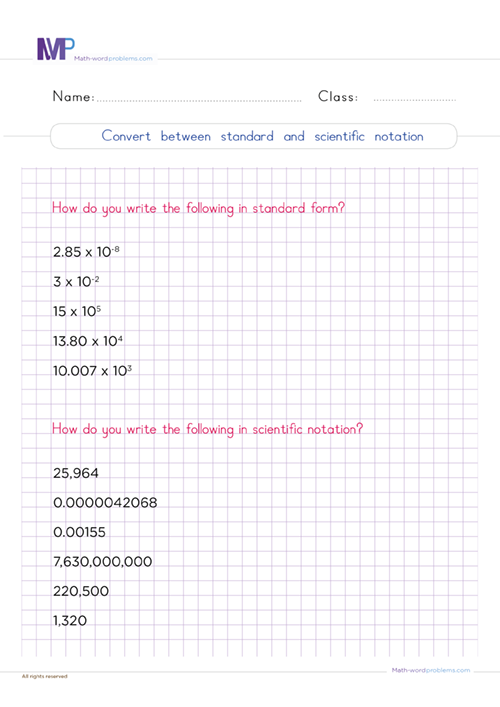
Compare numbers written in scientific notation
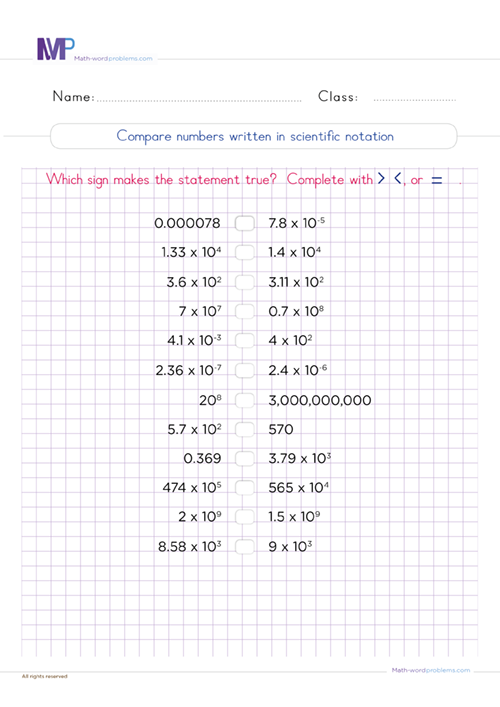
Example on how to find the GCF word problems
Step 1: First, read the problem discretely and identify the numbers you will be working with. The numbers are 28 and 35. Also, the keyword(s) found in the word problem is “greatest.”
Step 2: Next, how will you solve the problem? Clearly, from the situation, the problem is describing, and the keyword you need to look for the GCF .
So, with this in mind, Construct short expressions/sentences to represent the given word problem.
- Number of girls = 35
- Number of boys = 28
- Therefore, the greatest number of teams Miss Mariam can make if every student must be in a team = the GCF of 35 and 28.
Merge Step 3 and 4: when dealing with the GCF, step 3 and 4 are best understood when merged.
- Start by writing down a numerical expression to represent the bolded sentence in step 2 above , and then find the GCF of 28 and 35 using the prime factor method .
28 = 2 × 2 × 7. 35= 5 × 7.
28 = 2 × 2 × 7 . 35= 5 × 7 .
- Finally, to find the GCF , multiply their common factors together. Here, we only have 7 as the common factor.
Therefore, the GCF of 35 and 28 is 7.
So, Miss Mariam can make 7 teams if every student must be in a team.
GCF of 35 and 28 = 7
→ 35 girls ÷ 7 = 5 girls. → 28 boys ÷ 7 = 4 boys.
So, there must be 5 girls and 4 boys in a team.
Step 5: Finally, check your work to know if your answer makes sense through the following ways;
- Firstly, add the number of girls and boys that must be per team = 5 + 4 = 9
- Secondly, add the total number of girls and boys that are in the class = 35 + 28 = 63
- Finally, divide the total number of girls and boys that are in the class by the total number of girls and boys that must be per team = 63 ÷ 9 = 7
- So, since the final answer equals the GCF of 35 and 28, it implies that your answer is correct and makes sense .

WHAT’S THIS ALL ABOUT?
This is math-wordproblems.com a premium math quality website with original Math activities and other contents for math practice. We provide 100% free Math ressources for kids from Grade 2 to Grade 6 to improve children skills.
PRIVACY POLICY
Our team Don't Pass on to third parties any identifiable information about mathskills4kids.com users. Your email address and other information will NEVER be given or sold to a third party.
- Add And Subtract Fractions
- Addition And Subtraction Online Practice And Worksheets
- Comparing And Ordering
- Divide Fractions
- Estimating Comparing Ordering Rounding
- Fractions And Mixed Numbers
- Fractions Worksheets And Online Exercises With Answers
- Mixed Operations
- Multiplication
- Numbers Theory
- Solving And Estimation
- Subtraction
- Whole Numbers
- Second Grade
- Third Grade
- Fourth Grade
- Fifth Grade
- Sixth Grade
SUBSCRIBE TO OUR NEWSLETTER
Use of contents.
Many contents are released for free but you're not allow to share contents directly (we advice to share website links), don't use these contents in another website or for commercial issue. You're suppose to protect downloaded contents and take it for personal or classroom use. Special rule : Teachers can use our contents to teach in class.
Report a review
For more description, you can contact us here

Free Mathematics Tutorials
Solutions to questions on greatest common factor (gcf).
Detailed solutions of questions on greatest common factor are presented.
A Greatest Factor Calculator (GCF) may be used to check your answers.
- Find the greatest common factor of 36 and 42. Solution The prime factorization of 36 and 42 are: 36 = 2 × 2 × 3 × 3 42 = 2 × 3 × 7 GCF of 36 and 42 = 2 × 3 = 6
- Find the greatest common factor of 45, 60 and 75. Solution The prime factorization of 45, 60 and 75 are: 45 = 3 × 3 × 5 60 = 2 × 2 × 3 × 5 75 = 3 × 5 × 5 GCF of 45, 60 and 75 = 3 × 5 = 15
- What is the greatest common factor of of 360 and 252? Solution The prime factorization of 360 and 252 are: 360 = 2 × 2 × 2 × 3 × 3 × 5 252 = 2 × 2 × 3 × 3 × 7 GCF of 360 and 252 = 2 × 2 × 3 × 3 = 36
- What is the greatest common factor of 324, 666 and 756? Solution The prime factorization of 324, 666 and 756 are: 324 = 2 × 2 × 3 × 3 × 3 × 3 666 = 2 × 3 × 3 × 37 756 = 2 × 2 × 3 × 3 × 3 × 7 GCF of 324, 666 and 756 = 2 × 3 × 3 = 18
- a) Find the GCF of 12 and 16. b) Use the result in part a) to find the GCF of 1200 and 1600. Solution a) The prime factorization of 12 and 16 are: 12 = 2× 2 × 3 16 = 2 × 2 × 2 × 2 GCF of 12 and 16 = 2 × 2 = 4 b) We first note that 1200 = 12 × 100 = 2 × 2 × 3 × 100 1600 = 16 × 100 = 2 × 2 × 2 × 2 × 100 and so the greatest common factor to 1200 and 1600 is given by 2× 2 × 100 = 400
Links and References

- school Campus Bookshelves
- menu_book Bookshelves
- perm_media Learning Objects
- login Login
- how_to_reg Request Instructor Account
- hub Instructor Commons
- Download Page (PDF)
- Download Full Book (PDF)
- Periodic Table
- Physics Constants
- Scientific Calculator
- Reference & Cite
- Tools expand_more
- Readability
selected template will load here
This action is not available.

6.1: Greatest Common Factor and Factor by Grouping
- Last updated
- Save as PDF
- Page ID 30860

By the end of this section, you will be able to:
- Find the greatest common factor of two or more expressions
- Factor the greatest common factor from a polynomial
- Factor by grouping
Are you ready?
Before you get started, take this readiness quiz.
- Factor 56 into primes. If you missed this problem, review [link] .
- Find the least common multiple (LCM) of 18 and 24. If you missed this problem, review [link] .
- Multiply: \(−3a(7a+8b)\). If you missed this problem, review [link] .
Find the Greatest Common Factor of Two or More Expressions
Earlier we multiplied factors together to get a product . Now, we will reverse this process; we will start with a product and then break it down into its factors. Splitting a product into factors is called factoring .
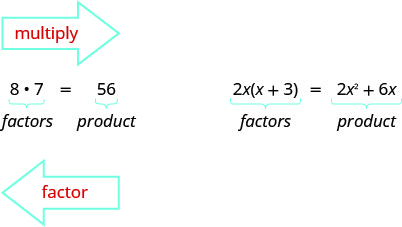
We have learned how to factor numbers to find the least common multiple (LCM) of two or more numbers. Now we will factor expressions and find the greatest common factor of two or more expressions. The method we use is similar to what we used to find the LCM.
GREATEST COMMON FACTOR
The greatest common factor (GCF) of two or more expressions is the largest expression that is a factor of all the expressions.
We summarize the steps we use to find the greatest common factor.
FIND THE GREATEST COMMON FACTOR (GCF) OF TWO EXPRESSIONS.
- Factor each coefficient into primes. Write all variables with exponents in expanded form.
- List all factors—matching common factors in a column. In each column, circle the common factors.
- Bring down the common factors that all expressions share.
- Multiply the factors.
The next example will show us the steps to find the greatest common factor of three expressions.
Example \(\PageIndex{1}\)
Find the greatest common factor of \(21x^3,\space 9x^2,\space 15x\).

Example \(\PageIndex{2}\)
Find the greatest common factor: \(25m^4,\space 35m^3,\space 20m^2.\)
Example \(\PageIndex{3}\)
Find the greatest common factor: \(14x^3,\space 70x^2,\space 105x\).
Factor the Greatest Common Factor from a Polynomial
It is sometimes useful to represent a number as a product of factors, for example, 12 as \(2·6\) or \(3·4\). In algebra, it can also be useful to represent a polynomial in factored form. We will start with a product, such as \(3x^2+15x\), and end with its factors, \(3x(x+5)\). To do this we apply the Distributive Property “in reverse.”
We state the Distributive Property here just as you saw it in earlier chapters and “in reverse.”
DISTRIBUTIVE PROPERTY
If a , b , and c are real numbers, then
\[a(b+c)=ab+ac \quad \text{and} \quad ab+ac=a(b+c)\nonumber\]
The form on the left is used to multiply. The form on the right is used to factor.
So how do you use the Distributive Property to factor a polynomial ? You just find the GCF of all the terms and write the polynomial as a product!
Example \(\PageIndex{4}\): How to Use the Distributive Property to factor a polynomial
Factor: \(8m^3−12m^2n+20mn^2\).

Example \(\PageIndex{5}\)
Factor: \(9xy^2+6x^2y^2+21y^3\).
\(3y^2(3x+2x^2+7y)\)
Example \(\PageIndex{6}\)
Factor: \(3p^3−6p^2q+9pq^3\).
\(3p(p^2−2pq+3q^3)\)
FACTOR THE GREATEST COMMON FACTOR FROM A POLYNOMIAL.
- Find the GCF of all the terms of the polynomial.
- Rewrite each term as a product using the GCF.
- Use the “reverse” Distributive Property to factor the expression.
- Check by multiplying the factors.
FACTOR AS A NOUN AND A VERB
We use “factor” as both a noun and a verb:
\[\begin{array} {ll} \text{Noun:} &\hspace{50mm} 7 \text{ is a factor of }14 \\ \text{Verb:} &\hspace{50mm} \text{factor }3 \text{ from }3a+3\end{array}\nonumber\]
Example \(\PageIndex{7}\)
Factor: \(5x^3−25x^2\).
Example \(\PageIndex{8}\)
Factor: \(2x^3+12x^2\).
\(2x^2(x+6)\)
Example \(\PageIndex{9}\)
Factor: \(6y^3−15y^2\).
\(3y^2(2y−5)\)
Example \(\PageIndex{10}\)
Factor: \(8x^3y−10x^2y^2+12xy^3\).
Example \(\PageIndex{11}\)
Factor: \(15x^3y−3x^2y^2+6xy^3\).
\(3xy(5x^2−xy+2y^2)\)
Example \(\PageIndex{12}\)
Factor: \(8a^3b+2a^2b^2−6ab^3\).
\(2ab(4a^2+ab−3b^2)\)
When the leading coefficient is negative, we factor the negative out as part of the GCF.
Example \(\PageIndex{13}\)
Factor: \(−4a^3+36a^2−8a\).
The leading coefficient is negative, so the GCF will be negative.
Example \(\PageIndex{14}\)
Factor: \(−4b^3+16b^2−8b\).
\(−4b(b^2−4b+2)\)
Example \(\PageIndex{15}\)
Factor: \(−7a^3+21a^2−14a\).
\(−7a(a^2−3a+2)\)
So far our greatest common factors have been monomials. In the next example, the greatest common factor is a binomial.
Example \(\PageIndex{16}\)
Factor: \(3y(y+7)−4(y+7)\).
The GCF is the binomial \(y+7\).
Example \(\PageIndex{17}\)
Factor: \(4m(m+3)−7(m+3)\).
\((m+3)(4m−7)\)
Example \(\PageIndex{18}\)
Factor: \(8n(n−4)+5(n−4)\).
\((n−4)(8n+5)\)
Factor by Grouping
Sometimes there is no common factor of all the terms of a polynomial. When there are four terms we separate the polynomial into two parts with two terms in each part. Then look for the GCF in each part. If the polynomial can be factored, you will find a common factor emerges from both parts. Not all polynomials can be factored. Just like some numbers are prime , some polynomials are prime.
Example \(\PageIndex{19}\): How to Factor a Polynomial by Grouping
Factor by grouping: \(xy+3y+2x+6\).

Example \(\PageIndex{20}\)
Factor by grouping: \(xy+8y+3x+24\).
\((x+8)(y+3)\)
Example \(\PageIndex{21}\)
Factor by grouping: \(ab+7b+8a+56\).
\((a+7)(b+8)\)
FACTOR BY GROUPING.
- Group terms with common factors.
- Factor out the common factor in each group.
- Factor the common factor from the expression.
Example \(\PageIndex{22}\)
Factor by grouping: ⓐ \(x^2+3x−2x−6\) ⓑ \(6x^2−3x−4x+2\).
ⓐ \(\begin{array} {ll} \text{There is no GCF in all four terms.} &x^2+3x−2x−6 \\ \text{Separate into two parts.} &x^2+3x\quad −2x−6 \\ \begin{array} {l} \text{Factor the GCF from both parts. Be careful} \\ \text{with the signs when factoring the GCF from} \\ \text{the last two terms.} \end{array} &x(x+3)−2(x+3) \\ \text{Factor out the common factor.} &(x+3)(x−2) \\ \text{Check on your own by multiplying.} & \end{array}\) ⓑ \(\begin{array} {ll} \text{There is no GCF in all four terms.} &6x^2−3x−4x+2 \\ \text{Separate into two parts.} &6x^2−3x\quad −4x+2\\ \text{Factor the GCF from both parts.} &3x(2x−1)−2(2x−1) \\ \text{Factor out the common factor.} &(2x−1)(3x−2) \\ \text{Check on your own by multiplying.} & \end{array}\)
Example \(\PageIndex{23}\)
Factor by grouping: ⓐ \(x^2+2x−5x−10\) ⓑ \(20x^2−16x−15x+12\).
ⓐ \((x−5)(x+2)\) ⓑ \((5x−4)(4x−3)\)
Example \(\PageIndex{24}\)
Factor by grouping: ⓐ \(y^2+4y−7y−28\) ⓑ \(42m^2−18m−35m+15\).
ⓐ \((y+4)(y−7)\) ⓑ \((7m−3)(6m−5)\)
Key Concepts
\[a(b+c)=ab+ac\quad \text{and}\quad ab+ac=a(b+c)\nonumber\]
\[\begin{array} {ll} \text{Noun:} &\quad 7 \text{ is a factor of } 14\\ \text{Verb:} &\quad \text{factor }3 \text{ from }3a+3\end{array}\nonumber\]
Word Problems that uses GCF or LCM (Worksheets)
Related Topics & Worksheets: Least Common Multiple More Math Worksheets
Objective: I can find the least common multiple or least common denominator.
Read the lesson on least common multiple if you need to learn how to find the lowest common multiple.
We use the least common multiple when adding or subtracting fractions with unlike denominators. It is then called the least common denominator.

We hope that the free math worksheets have been helpful. We encourage parents and teachers to select the topics according to the needs of the child. For more difficult questions, the child may be encouraged to work out the problem on a piece of paper before entering the solution. We hope that the kids will also love the fun stuff and puzzles.
We welcome your feedback, comments and questions about this site or page. Please submit your feedback or enquiries via our Feedback page.
- Number Charts
- Multiplication
- Long division
- Basic operations
- Telling time
- Place value
- Roman numerals
- Fractions & related
- Add, subtract, multiply, and divide fractions
- Mixed numbers vs. fractions
- Equivalent fractions
- Prime factorization & factors
- Fraction Calculator
- Decimals & Percent
- Add, subtract, multiply, and divide decimals
- Fractions to decimals
- Percents to decimals
- Percentage of a number
- Percent word problems
- Classify triangles
- Classify quadrilaterals
- Circle worksheets
- Area & perimeter of rectangles
- Area of triangles & polygons
- Coordinate grid, including moves & reflections
- Volume & surface area
- Pre-algebra
- Square Roots
- Order of operations
- Scientific notation
- Proportions
- Ratio word problems
- Write expressions
- Evaluate expressions
- Simplify expressions
- Linear equations
- Linear inequalities
- Graphing & slope
- Equation calculator
- Equation editor
- Elementary Math Games
- Addition and subtraction
- Math facts practice
- The four operations
- Factoring and number theory
- Geometry topics
- Middle/High School
- Statistics & Graphs
- Probability
- Trigonometry
- Logic and proof
- For all levels
- Favorite math puzzles
- Favorite challenging puzzles
- Math in real world
- Problem solving & projects
- For gifted children
- Math history
- Math games and fun websites
- Interactive math tutorials
- Math help & online tutoring
- Assessment, review & test prep
- Online math curricula

Brain Quest Workbook: Grade 6
The book boasts 300 pages jam-packed with curriculum-based activities and exercises in every subject, with a focus on math and language arts. Original full-color illustrations throughout give the book a bright, lively style that will appeal to older kids. It is engaging, user-friendly, and written to make schoolwork fun. Sixth graders will delve into research and analysis, metaphor and meaning, ratios and proportions, expressions and equations, and geometry. The workbook covers spelling and vocabulary, writing, social studies, science, and more.
See more Brain Quest workbooks at Amazon
How To Solve GCF Word Problems
Helping students turn a problem about GCF or LCM into a concrete model will help them understand what they are looking for and what steps they need to take to find the solution. The visual model helps them make sense of the situation so that they are not just relying on memorized steps.
A classic GCF problem has two quantities that need to be divided evenly into the greatest number of groups.
Mr. Gomez has 12 stickers and 18 gel pens. He wants to make the greatest number of packs possible with an equal number of stickers and an equal number of gel pens in each pack. How many packs can he make?
At this point, many students might confuse this with a GCF problem and say the answer is 36. Others will use a common factor such as 2 or 3 for their answer.
- How can students use a model to solve GCF word problems?
First attempt
Second attempt, third attempt, why should students use a model to solve gcf word problems, frequently asked questions on solving gcf word problems, 1. what is gcf, 2. how can students use a model to solve gcf word problems, 3. why should students use a model to solve gcf word problems, 4. where can i find more worksheets on solving gcf word problems .
100+ Free Math Worksheets, Practice Tests & Quizzes
GCF problems are all about equal groups. In order for a number to be a solution, we must be able to divide both numbers evenly into that number of groups.
It is good for students to act this out or draw this. Here we show you how students can make a drawing to model this situation. Notice the use of color in this model to represent stickers and pens.
Students can put all the stickers and pens into one bag but of course we can try making a few more bags – more fair to have more students getting fewer items than all goodies going to one student!!
The model shows that we could have 2 bags or 3 bags, because 12 stickers and 18 gel pens can be divided so that there would be the same number in each bag.
But is this the greatest number of bags? Four bags will not work because 18 cannot be divided into 4 equal groups.
The strategy can continue until all possible groups have been tested. The solution is the greatest number of groups that work for both numbers. The model also provides an opportunity to describe the answer. There will be 6 bags. Each bag will have 2 stickers and 3 gel pens.
Drawing the groups can be time-consuming for larger numbers, but using counters works well too. Creating the arrays helps deepen the connection between factors, using arrays for multiplication, and area models.
By using a model, students have moved away from blindly applying GCF or LCM. They make sense of the situation. They try out different options. They don’t have to remember or guess what the concept is supposed to be.
We could give different pairs of students different situations, ask them to do a poster and then conduct a gallery walk. Students will notice that all factors work and that the greatest common factor is what ends up solving the problem. It also helps them to see what actually is happening inside of the groups – how many stickers and pens are in each group.
Also read: How To Solve LCM Problems
The digital co-teacher made with ❤️ by teachers
ByteLearn saves you time and ensures every student gets the support they need
It is the largest of all the factors that are common to two or more numbers. Example: GCF of 12 and 18. You can list all the factors of 12 and 18. Then find the greatest common factor. 12: 1, 2, 3, 4, 6 , 12 18: 1, 2, 3, 6 , 9, 18 GCF(12, 18) = 6
When using the model to solve GCF word problems, all the common factors like 1, 2, 3, 6 represent the number of groups that can be formed. 6 represents the largest number of groups that can be formed.
Students should create a chart with two columns and multiple rows. The two columns stand for the items being split up. Each row represents the number of groups the item is split into. Students keep trying more and more groups till they have exhausted all options.
Students can work in pairs in different scenarios. Conduct a gallery walk with student work. Students will soon come to the conclusion that only common factors work for a number of groups and that the GCF is the largest number of groups you can make.
Solving GCF and LCM word problems is confusing. By using a model, students make sense of the situation. They do not need to memorize the steps.
You can find math worksheets on GCF problems and other exclusive math resources, here .
Free, standards-aligned math worksheets
Enter your email and we’ll send you samples of our most popular math worksheets.
10 Strategies for Motivating Students in Mathematics
25 Classroom Management Strategies and Techniques
20 Fun First Day of School Activities to Try for Middle School Math Class
11 Inspiring Black History Month Math Activities for Students
130 Math Word Problems To Challenge Students Grades 1 to 8
50 Fun Math Brain Teasers for Kids With Answers
111 Silly Math Jokes and Puns to Make Students Laugh Like crazy
10 Popular Common Core Math Standards Explained with Examples in the Classroom
About the author.
John Maloney
Comments are closed.

Child Login
- Kindergarten
- Number charts
- Skip Counting
- Place Value
- Number Lines
- Subtraction
- Multiplication
- Word Problems
- Comparing Numbers
- Ordering Numbers
- Odd and Even
- Prime and Composite
- Roman Numerals
- Ordinal Numbers
- In and Out Boxes
- Number System Conversions
- More Number Sense Worksheets
- Size Comparison
- Measuring Length
- Metric Unit Conversion
- Customary Unit Conversion
- Temperature
- More Measurement Worksheets
- Writing Checks
- Profit and Loss
- Simple Interest
- Compound Interest
- Tally Marks
- Mean, Median, Mode, Range
- Mean Absolute Deviation
- Stem-and-leaf Plot
- Box-and-whisker Plot
- Permutation and Combination
- Probability
- Venn Diagram
- More Statistics Worksheets
- Shapes - 2D
- Shapes - 3D
- Lines, Rays and Line Segments
- Points, Lines and Planes
- Transformation
- Quadrilateral
- Ordered Pairs
- Midpoint Formula
- Distance Formula
- Parallel, Perpendicular and Intersecting Lines
- Scale Factor
- Surface Area
- Pythagorean Theorem
- More Geometry Worksheets
- Converting between Fractions and Decimals
- Significant Figures
- Convert between Fractions, Decimals, and Percents
- Proportions
- Direct and Inverse Variation
- Order of Operations
- Squaring Numbers
- Square Roots
- Scientific Notations
- Speed, Distance, and Time
- Absolute Value
- More Pre-Algebra Worksheets
- Translating Algebraic Phrases
- Evaluating Algebraic Expressions
- Simplifying Algebraic Expressions
- Algebraic Identities
- Quadratic Equations
- Systems of Equations
- Polynomials
- Inequalities
- Sequence and Series
- Complex Numbers
- More Algebra Worksheets
- Trigonometry
- Math Workbooks
- English Language Arts
- Summer Review Packets
- Social Studies
- Holidays and Events
- Worksheets >
- Pre-Algebra >
Greatest Common Factor (GCF) Worksheets
A large collection of GCF worksheets is meticulously drafted for students in grade 5 through grade 8. GCF is also known as 'greatest common divisor'(GCD), 'highest common factor'(HCF), 'greatest common measure'(GCM) or 'highest common divisor'(HCD). Download and print these GCF worksheets to find the GCF of two numbers, three numbers and more. Try some of these handouts for free!
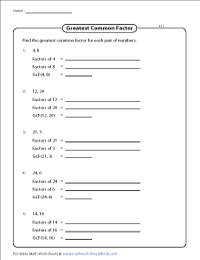
GCF: Descriptive
List the factors for each pair of numbers. Then, compare to determine the GCF of the two numbers. The printable worksheets are categorized into three levels based on the range of numbers.
- Download the set
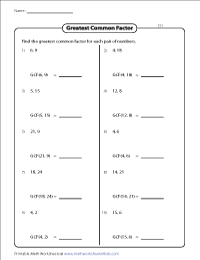
GCF of Two Numbers: Standard
Use the prime factorization method to find the GCF for each pair of numbers. This batch of multi-level worksheet pdfs contains a total of 150 problems for 5th grade and 6th grade students. Use the answer key to validate your solutions.
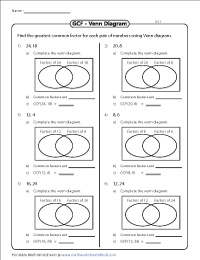
GCF of Two Numbers using Venn Diagrams | Easy
Write down the factors for each pair of numbers in the Venn diagram. Then, list out the common factors in the intersection. The largest factor listed in the overlapping region is the GCF. This set includes numbers up to 25.
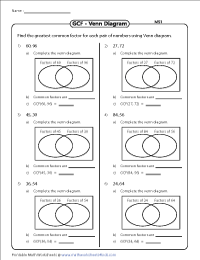
GCF of Two Numbers using Venn Diagrams | Moderate
Brighten your math class by using Venn Diagrams to find the GCF of two numbers. Featuring numbers up to 99, this compilation requires learners to list out the factors, place the common factors in the overlapping region, and find the GCF.
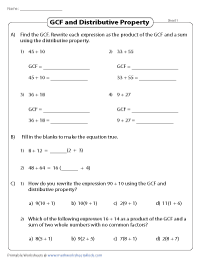
GCF and Distributive Property
Being good at something isn’t enough, aim for greatness! Choose our pdf worksheets on GCF and Distributive Property and practice rewriting expressions as the product of the GCF and a sum using the property.
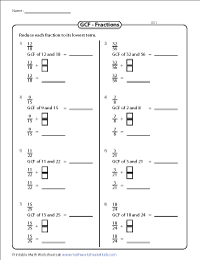
Simplify Fractions using GCF | Easy
Find the GCF for the numerator and the denominator of the given fraction in this set of printable worksheets. Then, reduce the fraction to its lowest term by dividing the numerator and denominator by the GCF. Numbers up to 25 are included in this section.
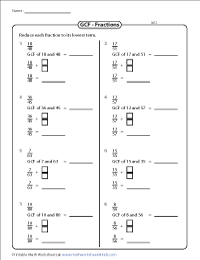
Simplify Fractions using GCF | Moderate
Facilitate better understanding of GCF by reviewing your skill with this bundle of printable worksheets that features numbers up to 99. Practice finding the GCF and simplifying the fraction using the GCF.
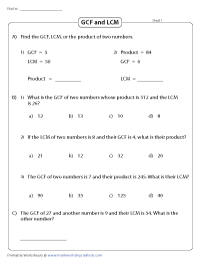
GCF, LCM and the Product
There’s a solid relationship between GCF, LCM, and the product of two numbers. Broaden your knowledge with our pdf worksheets and be the first in class to ace this enthralling topic!
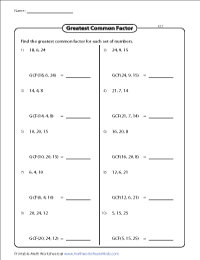
GCF of Three Numbers | Easy
In this bunch of 7th grade and 8th grade pdf worksheets, determine the GCF for the set of three numbers. Apply prime factorization method to list out the common factors. Multiply the common factors to obtain the GCF of the three numbers.
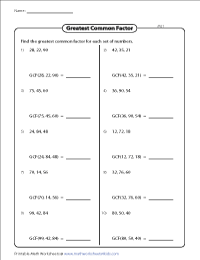
GCF of Three Numbers | Moderate
It’s time to get acquainted with GCF of three numbers by working out the exercises in these pdfs covering numbers up to 99. Work out the GCF by finding the product of the prime factors common to all three numbers.
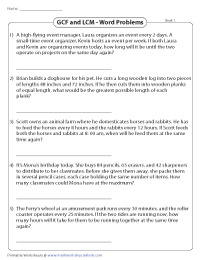
GCF and LCM word problems
Let’s explore GCF and LCM in the real word using heaps of realistic word problems! Solve life-like situations that impel you to think about the applications of great common factor and least common multiple like never before!
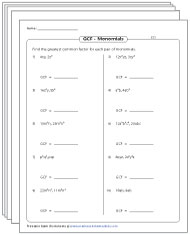
GCF of Polynomials
Gain an in-depth knowledge in finding the Greatest Common Factor of polynomials with these high school worksheets available in easy and moderate levels, find the GCF of two or three monomials, GCF of polynomials, find the GCF using the division method and more!
(45 Worksheets)
Related Worksheets
» Least Common Multiples
» Factoring Numbers
» Factoring Polynomials
Become a Member
Membership Information
Privacy Policy
What's New?
Printing Help
Testimonial
Copyright © 2024 - Math Worksheets 4 Kids
This is a members-only feature!

Gcf and Lcm Word Problems Worksheets
GCF and LCM word problems worksheets can help encourage students to read and think about the questions, rather than simply recognizing a pattern to the solutions. GCF and LCM word problems worksheets come with the answer key and detailed solutions which the students can refer to anytime.
Benefits of GCF and LCM Word Problems Worksheets
GCF and LCM word problems worksheets help kids to improve their speed, accuracy, logical and reasoning skills.
GCF and LCM word problems worksheets give students the opportunity to solve a wide variety of problems helping them to build a robust mathematical foundation. GCF and LCM word problems worksheets help kids to improve their speed, accuracy, logical and reasoning skills in performing simple calculations related to the topic of GCF and LCM.
GCF and LCM word problems worksheets are also helpful for students to prepare for various competitive exams.
These worksheets come with visual simulation for students to see the problems in action, and provides a detailed step-by-step solution for students to understand the process better, and a worksheet properly explained about the GCF and LCM.
Download GCF and LCM Word Problems Worksheet PDFs
These math worksheets should be practiced regularly and are free to download in PDF formats.
☛ Check Grade wise GCF and LCM Worksheets
- Grade 6 LCM Worksheets
- 6th Grade GCF Worksheets
- Child Login
- Number Sense
- Measurement
- Pre Algebra
- Figurative Language
- Reading Comprehension
- Reading and Writing
- Science Worksheets
- Social Studies Worksheets
- Math Worksheets
- ELA Worksheets
- Online Worksheets
Browse By Grade
- Become a Member

- Kindergarten

- Skip Counting
- Place Value
- Number Lines
- Subtraction
- Multiplication
- Word Problems
- Comparing Numbers
- Ordering Numbers
- Odd and Even Numbers
- Prime and Composite Numbers
- Roman Numerals
- Ordinal Numbers

- Big vs Small
- Long vs Short
- Tall vs Short
- Heavy vs Light
- Full and Empty
- Metric Unit Conversion
- Customary Unit Conversion
- Temperature

- Tally Marks
- Mean, Median, Mode, Range
- Mean Absolute Deviation
- Stem and Leaf Plot
- Box and Whisker Plot
- Permutations
- Combinations

- Lines, Rays, and Line Segments
- Points, Lines, and Planes
- Transformation
- Ordered Pairs
- Midpoint Formula
- Distance Formula
- Parallel and Perpendicular Lines
- Surface Area
- Pythagorean Theorem

- Significant Figures
- Proportions
- Direct and Inverse Variation
- Order of Operations
- Scientific Notation
- Absolute Value

- Translating Algebraic Phrases
- Simplifying Algebraic Expressions
- Evaluating Algebraic Expressions
- Systems of Equations
- Slope of a Line
- Equation of a Line
- Quadratic Equations
- Polynomials
- Inequalities
- Determinants
- Arithmetic Sequence
- Arithmetic Series
- Geometric Sequence
- Complex Numbers
- Trigonometry
GCF and LCM Word Problems Worksheets
- Pre-Algebra >
- Factors >
- GCF and LCM Word Problems
Our printable worksheets on GCF and LCM word problems are an effective resource that dramatically improves problem-solving skills. Children are expected to read the scenario carefully and look for keywords that help determine whether they need to find the lowest common multiple or the greatest common factor. Have a blitz on our effective practice resources!
Our pdf LCM and GCD word problems worksheets are ideal for 6th grade and 7th grade children.
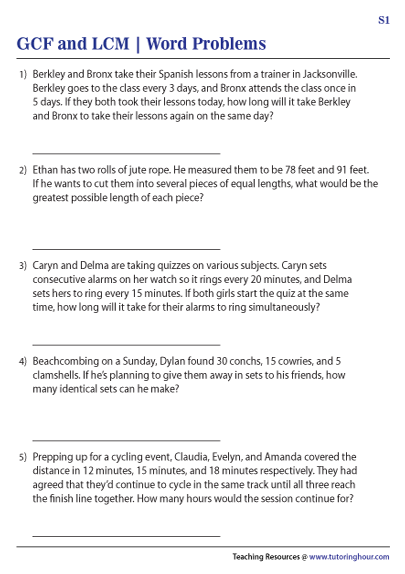
Related Printable Worksheets
▶ Greatest Common Factor
▶ Least Common Multiple
Tutoringhour
What we offer, information.
- Membership Benefits
- How to Use Online Worksheets
- How to Use Printable Worksheets
- Printing Help
- Testimonial
- Privacy Policy
- Refund Policy
Copyright © 2024 - Tutoringhour
You must be a member to unlock this feature!
Sign up now for only $29.95/year — that's just 8 cents a day!
Printable Worksheets
- 20,000+ Worksheets Across All Subjects
- Access to Answer Key
- Add Worksheets to "My Collections"
- Create Custom Workbooks
Digitally Fillable Worksheets
- 1100+ Math and ELA Worksheets
- Preview and Assign Worksheets
- Create Groups and Add Children
- Track Progress
- Texas Go Math
- Big Ideas Math
- Engageny Math
- McGraw Hill My Math
- enVision Math
- 180 Days of Math
- Math in Focus Answer Key
- Math Expressions Answer Key
- Privacy Policy
Examples of Greatest Common Factor (GCF) | Finding GCD Examples with Answers
In Mathematics, the Greatest Common Factor of two or more numbers is the greatest positive integer x, which divides both the given numbers. The Greatest Common Factor is additionally referred to as GCF. In this Greatest can be replaced with highest, and factor can be replaced with Divisor. So GCF is also known as HCF (Highest Common Factor), Greatest Common Divisor (GCD), and Highest Common Divisor (HCD).
On this page for better understanding, we will provide various questions with a quick explanation here. In this article, we have covered different questions on Greatest Common Factor (GCF) for enhancing their skills as well as better practice. GCF is used most of the time with fractions, which are used a great deal in everyday lifestyle.
Also, Refer:
- Highest Common Factor
- Examples of Highest Common Factor
- Worksheet on HCF and LCM
Examples of finding Greatest Common Factor(GCF)
Problem 1: Find the GCF of 72 and 81.
Solution: Given the values are 72, and 81. Now, we will the factors. So, the factors of 72 are 1, 2, 3, 4, 6, 8, 9, 12, 18. Factors of 81 are 1, 3, 9, 27. So, the common factors of 72, 81 are 1, 3, 9. Next, write the Greatest Common Factor among them is 9. Thus, the Greatest Factor of the given numbers is 9.
Problem 2: What is the Greatest Common Factor (GCF) of 11, 121, 143?
Solution: As given in the question, the values are 11, 121, 143. Now, will find the greatest common factor. So, first, write the common factors. The factors of 11 are 1, 11 The factors of 121 are 1, 11 The factors of 143 are 1, 11, The common factors of 11, 121, 143 are 1, 11. Therefore, the Greatest Common factor among them is 11.
Problem 3: Let us write the Greatest Factor of 15 and 35.
Solution: Given the values, First, we have to list the factors of 15 and 35 and then find out the common factors. Now, write the factors of 15 are 1, 3, 5, and 15. The factors of 35 are 1, 5, 7. The common factors of 15 and 35 are 1, 5. Among these numbers, 5 is the greatest (largest) number. Thus, the GCF of 15 and 35 is 5. This is written as GCF(15, 35) = 5.
Problem 4: What is the GCF of 26, 62?
Solution: Given the values, 26 and 62. Now, write the factors. The factors of 26 are 1, 2, 13. The factors of 62 are 1, 2. So, the common factors are 1, 2. Among them, the Greatest (largest) factor is 2. Therefore, the Greatest Common Factor of 26 and 62 is 2.
Problem 5: Find the GCF (Greatest Common Factor) of 48, 148, and 36 using the prime factorization.
Solution: Given the values for finding GCF is 48, 148, and 36. Using Prime Factorization, now write the factors. So, the factors of 48 are 2 x 2 x 2 x 6. Factors of 148 are 2 x 2 x 37. The factors of 36 are 2 x 2 x 3 x 3. The common factors are 2 x 2 = 4 Thus, the GCF of given numbers is 4.
Practice Math Online with Unlimited Questions provided in 5th Grade Math Activity Sheets and become a blossoming mathematician in no time.
Problem 6: What is the greatest common factor of 45,120?
Solution: Given the values are 45, 120. Now, we have to write the factors of 45 are 1, 3, 5, 9, 15. The Factors of 120 are 1, 2, 3, 4, 5, 6, 8, 10, 12, 15. Therefore, the common factors of 45 and 120 are 1, 3, 5, and 15. Hence, the Greatest Common divisor (GCD) or GCF of the given numbers is 15.
Problem 7: Write the Greatest Common Factors of 77, 99, 121?
Solution: Given the values 77, 99, and 121. First, write the common factor. The factors of 77 are 1, 7, and 11. The factors of 99 are 1, 3, 11. The factors of 121 are 1, 11 Therefore, the common factors are 1, 11. So, the Greatest Common Factor (GCF) of 77, 99, and 121 is 11.
Problem 8: Two pipes are 32m and 36m long. The pipes are to be cut into pieces of equal length. Find each piece’s maximum length of pipe.
Solution: As given in the question, Two pipes length is 32m and 36m. GCF is the required length of each piece of pipe. 32 = 2 x 16 36 = 2 x 28 The common greatest factor is 2. Hence, the required pipe maximum length of each piece is 2m.
Problem 9: Find the greatest common divisor (GCD) of 128 and 96.
Solution: Given the values, By Using the method of prime factorisation, The factors of 128 are 2 x 2 x 2 x 2 x 2 x 2 x 2 The factors of 96 are 2 x 2 x 2 x 2 x 2 x 3 Now, write the Common factors of GCF (128, 96) = 2 x 2 x 2 x 2 x2 = 32. Thus, the GCF is 32.
By Euclid’s division algorithm, 128 = 96 x 1 + 32 96 = 32 x 3 + 0 Hence, the Greatest Common Factor (GCF) of 128 and 96 is 32.
Problem 10: What is the GCF of 19 and 17?
Solution: Given the values, First, we have to list the factors of 19 and 17 and then find out the common factors. The factors of 19 are 1, and 19. The factors of 17 are 1, and 17. The common factors of seven and 17 are 1. Among these numbers, 1 is the greatest (largest) number. Thus, the GCF of 19 and 17 is 1. This is written as GCF(19, 17) = 1.
FAQ’s on Examples of GCF
1. Write the difference between the HCF and GCF?
The HCF and GCF both are the same. There is no difference between HCF and GCD. Greatest Common Factor (GCF), Greatest Common Measure (GCM), and Highest Common Divisor all are similar.
2. Is GCF and LCM both are the same?
LCM stands for Least Common Multiple. LCM of two numbers is the smaller value that is divisible by both two numbers. Whereas GCF is the highest common factor of two numbers, which can divide the two numbers evenly. Therefore, LCM and GCD are different.
3. Is GCD and HCF the same?
GCD is that the Greatest common divisor and HCF are that the Highest Common Factor. Both are the same.
4. What are the Applications of Greatest Common Factor (GCF)?
The concept of the greatest divisor or the highest common factor is employed in many real-life incidents. Other applications like arranging students in rows and columns in equal numbers, diving a group of people into smaller sections, and etc.,
Leave a Comment Cancel Reply
You must be logged in to post a comment.

IMAGES
VIDEO
COMMENTS
To solve this problem, the first thing we have to do is break down both numbers into prime factors. 24 = 2 3 x 3. 18 = 2 x 3 2. Now, to calculate the GCF, we need to choose the common factors with the smallest exponent, which in this case will be the 2 and the 3. Once we've chosen our common factors, all we have to do is multiply them by each ...
Problem 6 : Two numbers are in the ratio 3 : 5 and their greatest common factor is 18. Find the numbers. Solution : Because the two numbers are in the ratio 3 : 5, the numbers can be assumed as 3x and 5x. Greatest common factor (3x, 5x) = x. But, it is given that the greatest common factor of the two numbers is 18. Then, x = 18
GCF & LCM word problems. Google Classroom. You might need: Calculator. Ronald and Tim both did their laundry today. Ronald does laundry every 6 days and Tim does laundry every 9 days. How many days will it be until Ronald and Tim both do laundry on the same day again? days. Show Calculator.
These word problems need the use of greatest common factors (GCFs) or least common multiples (LCMs) to solve. Mixing GCF and LCM word problems encourages students to read and think about the questions, rather than simply recognizing a pattern to the solutions. Worksheet #1 Worksheet #2 Worksheet #3 Worksheet #4. Worksheet #5 Worksheet #6. Similar:
The Greatest Common Factor (GCF) or Greatest Common Divisor (GCD) = 2. This is the largest number that you can divide evenly into both 4 and 6. ... Some ways you can tell is for GCF, the problem will ask for the GREATEST amount of something while for LCM, the problem will ask for the LEAST amount of something. ... And so the answer is 120. And ...
Step 1: Identify what numbers of which we will find the GCF. Step 2: Use the slide method to determine the GCF of these numbers. Step 3: Provide the GCF in the context of the problem.
Problem. Find the greatest common factor of 42,28, and 70 . Your answer should be. an integer, like 6. a simplified properfraction, like 3/5. a simplified improperfraction, like 7/4. a mixed number, like 1 3/4. an exactdecimal, like 0.75. a multiple of pi, like 12 pi or 2/3 pi.
Developed by MIT graduates, MathScore provides online math practice for Greatest Common Factor and hundreds of other types of math problems. ... Problem Correct Answer Your Answer; 2: 143, 110: Solution The factors of 110 are 1, 2, 5, 10, 11, 22, 55, 110.
3.1 Use a Problem-Solving Strategy; 3.2 Solve Percent Applications; 3.3 Solve Mixture Applications; ... If you missed this problem, review Example 1.10. Be Prepared 7.3. Simplify −3 (6 a + 11) ... Find the Greatest Common Factor of Two or More Expressions. In the following exercises, find the greatest common factor. 1. 8, 18. 2.
Find the Greatest Common Factor (GCF) of two expressions. Step 1. Factor each coefficient into primes. Write all variables with exponents in expanded form. Step 2. List all factors—matching common factors in a column. In each column, circle the common factors. Step 3. Bring down the common factors that all expressions share.
Find the greatest common factor (GCF) of two expressions. Step 1. Factor each coefficient into primes. Write all variables with exponents in expanded form. Step 2. List all factors—matching common factors in a column. In each column, circle the common factors. Step 3. Bring down the common factors that all expressions share.
Firstly, find the prime factors of each number. 28 = 2 × 2 × 7. 35= 5 × 7. Secondly, find and highlight the prime factors that the factors have in common. 28 = 2 × 2 × 7. 35= 5 × 7. Finally, to find the GCF, multiply their common factors together. Here, we only have 7 as the common factor. Therefore, the GCF of 35 and 28 is 7.
Detailed solutions of questions on greatest common factor are presented. A Greatest Factor Calculator (GCF) may be used to check your answers. Find the greatest common factor of 36 and 42. Solution. The prime factorization of 36 and 42 are: 36 = 2 × 2 × 3 × 3. 42 = 2 × 3 × 7. GCF of 36 and 42 = 2 × 3 = 6. Find the greatest common factor ...
Find the greatest common factor of \ (21x^3,\space 9x^2,\space 15x\). Factor each coefficient into primes and write the variables with exponents in expanded form. Circle the common factors in each column. Bring down the common factors. Multiply the factors. The GCF of \ (21x^3\), \ (9x^2\) and \ (15x\) is \ (3x\).
The GCF can be used to solve word problems that are looking for groups, sets, For example, in the following word problems they are looking for equal groups. ...
Solve the following problems: a) Tim has a bag of 36 orange-flavoured sweets and Peter has a bag of 44 grape-flavoured sweets. They have to divide up the sweets into small trays with equal number of sweets; each tray containing either orange-flavoured or grape-flavoured sweets only. If there is no remainder, find the largest possible number of ...
NOTE: The largest number allowed for GCF is 1,000,000 and for LCM 10,000 to be safe (to reduce the server load). Basic instructions for the worksheets. Each worksheet is randomly generated and thus unique. The answer key is automatically generated and is placed on the second page of the file.. You can use the generator to make worksheets either in html or PDF format — both are easy to print.
Helping students turn a problem about GCF or LCM into a concrete model will help them understand what they are looking for and what steps they need to take to find the solution. The visual model helps them make sense of the situation so that they are not just relying on memorized steps.. A classic GCF problem has two quantities that need to be divided evenly into the greatest number of groups.
A large collection of GCF worksheets is meticulously drafted for students in grade 5 through grade 8. GCF is also known as 'greatest common divisor' (GCD), 'highest common factor' (HCF), 'greatest common measure' (GCM) or 'highest common divisor' (HCD). Download and print these GCF worksheets to find the GCF of two numbers, three numbers and more.
These math worksheets should be practiced regularly and are free to download in PDF formats. GCF and LCM Word Problems Worksheet - 1. Download PDF. GCF and LCM Word Problems Worksheet - 2. Download PDF. GCF and LCM Word Problems Worksheet - 3. Download PDF. GCF and LCM Word Problems Worksheet - 4. Download PDF.
Clear explanation on how to analyze problem solving involving Greatest Common Factor and Least Common Multiple.
Our pdf LCM and GCD word problems worksheets are ideal for 6th grade and 7th grade children. Worksheet 1. Worksheet 2. Worksheet 3. Greatest Common Factor. Least Common Multiple. Try our free worksheets on GCF and LCM word problems to find the greatest common divisor and the least common multiple with life-like, relatable scenarios.
Therefore, the Greatest Common Factor of 26 and 62 is 2. Problem 5: Find the GCF (Greatest Common Factor) of 48, 148, and 36 using the prime factorization. Solution: Given the values for finding GCF is 48, 148, and 36. Using Prime Factorization, now write the factors. So, the factors of 48 are 2 x 2 x 2 x 6. Factors of 148 are 2 x 2 x 37.